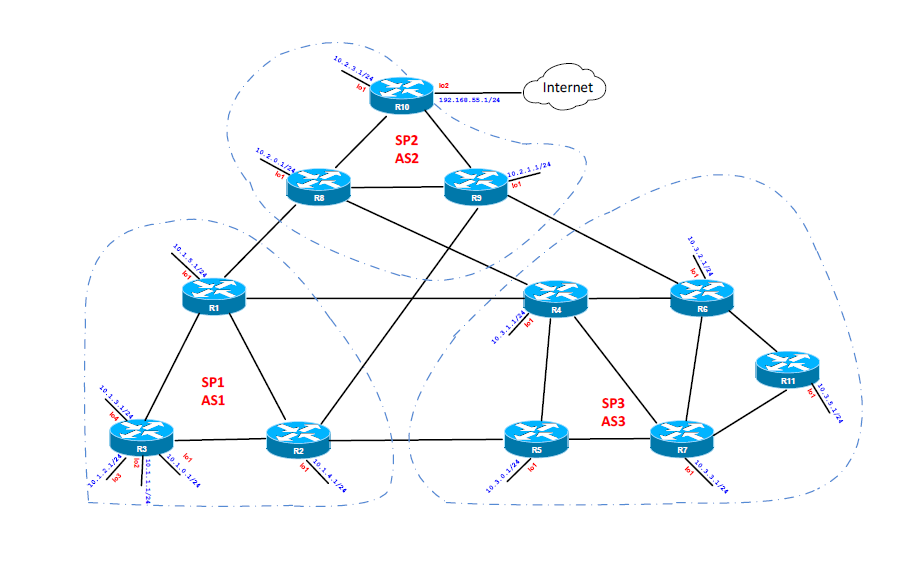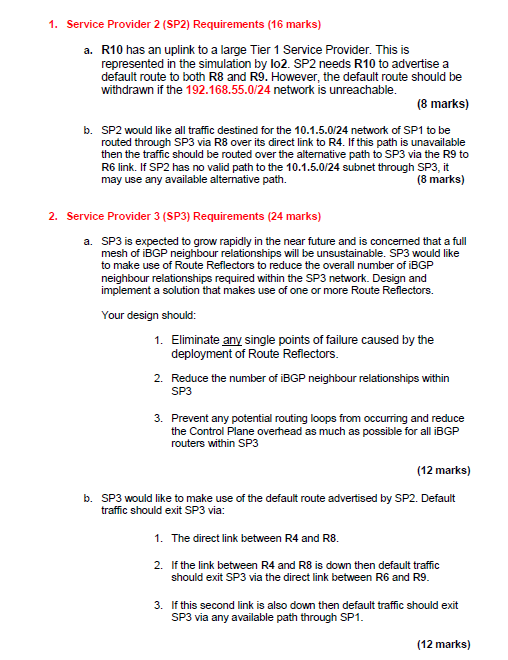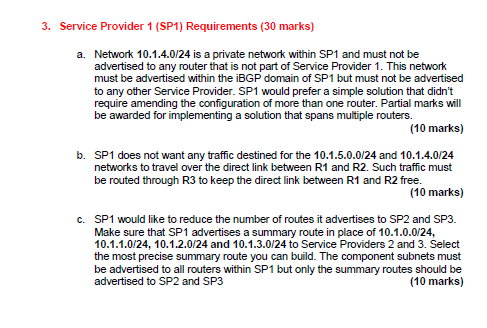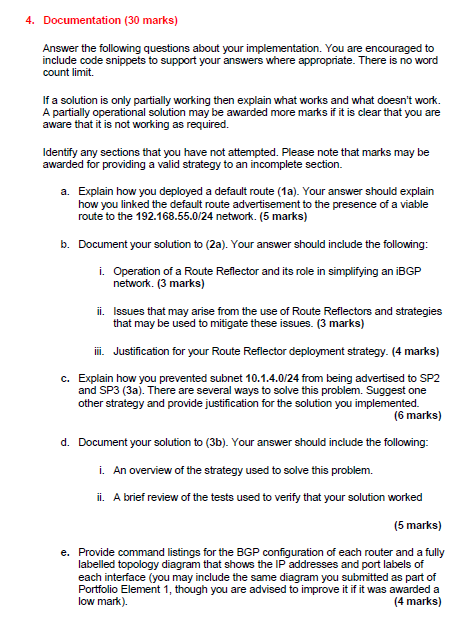Answered step by step
Verified Expert Solution
Question
1 Approved Answer
10.1.3.1/24 201 10.1.2.1/24 R3 10.1.8.1/24 R1 SP1 AS1 101 10.1.0.1/24 10.2.0.1/24 R2 RB 10.2.3.1/24 lo1 16.1.4.1/24 R10 SP2 AS2 lo2 192.168.55.1/24 R9 10.2.1.1/24 01




10.1.3.1/24 201 10.1.2.1/24 R3 10.1.8.1/24 R1 SP1 AS1 101 10.1.0.1/24 10.2.0.1/24 R2 RB 10.2.3.1/24 lo1 16.1.4.1/24 R10 SP2 AS2 lo2 192.168.55.1/24 R9 10.2.1.1/24 01 16.3.1.1/24) tot R5 101 19.3.0.1/24 Internet R4 SP3 AS3 10.3.2.1/24 R7 RG lot 10.3.3.1/24 R11 10.3.5.1/24 1. Service Provider 2 (SP2) Requirements (16 marks) a. R10 has an uplink to a large Tier 1 Service Provider. This is represented in the simulation by Io2. SP2 needs R10 to advertise a default route to both R8 and R9. However, the default route should be withdrawn if the 192.168.55.0/24 network is unreachable. (8 marks) b. SP2 would like all traffic destined for the 10.1.5.0/24 network of SP1 to be routed through SP3 via R8 over its direct link to R4. If this path is unavailable then the traffic should be routed over the alternative path to SP3 via the R9 to R6 link. If SP2 has no valid path to the 10.1.5.0/24 subnet through SP3, it may use any available alternative path. (8 marks) 2. Service Provider 3 (SP3) Requirements (24 marks) a. SP3 is expected to grow rapidly in the near future and is concerned that a full mesh of IBGP neighbour relationships will be unsustainable. SP3 would like to make use of Route Reflectors to reduce the overall number of iBGP neighbour relationships required within the SP3 network. Design and implement a solution that makes use of one or more Route Reflectors. Your design should: 1. Eliminate any single points of failure caused by the deployment of Route Reflectors. 2. Reduce the number of IBGP neighbour relationships within SP3 3. Prevent any potential routing loops from occurring and reduce the Control Plane overhead as much as possible for all iBGP routers within SP3 (12 marks) b. SP3 would like to make use of the default route advertised by SP2. Default traffic should exit SP3 via: 1. The direct link between R4 and R8. 2. If the link between R4 and R8 is down then default traffic should exit SP3 via the direct link between R6 and R9. 3. If this second link is also down then default traffic should exit SP3 via any available path through SP1. (12 marks) 3. Service Provider 1 (SP1) Requirements (30 marks) a. Network 10.1.4.0/24 is a private network within SP1 and must not be advertised to any router that is not part of Service Provider 1. This network must be advertised within the IBGP domain of SP1 but must not be advertised to any other Service Provider. SP1 would prefer a simple solution that didn't require amending the configuration of more than one router. Partial marks will be awarded for implementing a solution that spans multiple routers. (10 marks) b. SP1 does not want any traffic destined for the 10.1.5.0.0/24 and 10.1.4.0/24 networks to travel over the direct link between R1 and R2. Such traffic must be routed through R3 to keep the direct link between R1 and R2 free. (10 marks) c. SP1 would like to reduce the number of routes it advertises to SP2 and SP3. Make sure that SP1 advertises a summary route in place of 10.1.0.0/24, 10.1.1.0/24, 10.1.2.0/24 and 10.1.3.0/24 to Service Providers 2 and 3. Select the most precise summary route you can build. The component subnets must be advertised to all routers within SP1 but only the summary routes should be advertised to SP2 and SP3 (10 marks) 4. Documentation (30 marks) Answer the following questions about your implementation. You are encouraged to include code snippets to support your answers where appropriate. There is no word count limit. If a solution is only partially working then explain what works and what doesn't work. A partially operational solution may be awarded more marks if it is clear that you are aware that it is not working as required. Identify any sections that you have not attempted. Please note that marks may be awarded for providing a valid strategy to an incomplete section. a. Explain how you deployed a default route (1a). Your answer should explain how you linked the default route advertisement to the presence of a viable route to the 192.168.55.0/24 network. (5 marks) b. Document your solution to (2a). Your answer should include the following: i. Operation of a Route Reflector and its role in simplifying an IBGP network. (3 marks) ii. Issues that may arise from the use of Route Reflectors and strategies that may be used to mitigate these issues. (3 marks) iii. Justification for your Route Reflector deployment strategy. (4 marks) c. Explain how you prevented subnet 10.1.4.0/24 from being advertised to SP2 and SP3 (3a). There are several ways to solve this problem. Suggest one other strategy and provide justification for the solution you implemented. (6 marks) d. Document your solution to (3b). Your answer should include the following: i. An overview of the strategy used to solve this problem. ii. A brief review of the tests used to verify that your solution worked (5 marks) e. Provide command listings for the BGP configuration of each router and a fully labelled topology diagram that shows the IP addresses and port labels of each interface (you may include the same diagram you submitted as part of Portfolio Element 1, though you are advised to improve it if it was awarded a low mark). (4 marks)
Step by Step Solution
There are 3 Steps involved in it
Step: 1

Get Instant Access to Expert-Tailored Solutions
See step-by-step solutions with expert insights and AI powered tools for academic success
Step: 2

Step: 3

Ace Your Homework with AI
Get the answers you need in no time with our AI-driven, step-by-step assistance
Get Started


